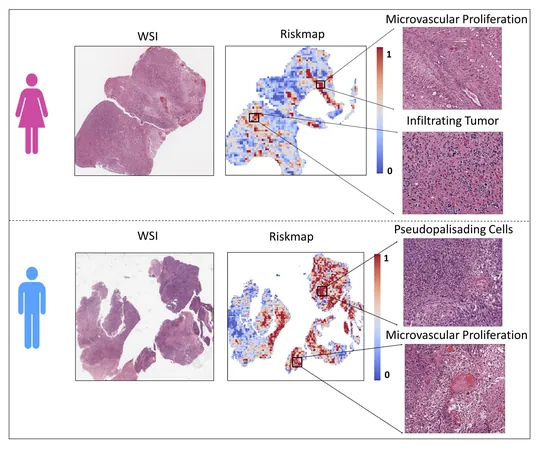
Unleashing AI's Power: How New Advances Could Revolutionize Brain Tumor Treatment and Improve Prognosis
2024-10-07
Author: Rajesh
Introduction
For years, the medical community has grappled with a disturbing pattern: glioblastoma, a particularly aggressive form of brain cancer, strikes men more frequently than women, and those tumors often behave more harshly in male patients. However, identifying the specific characteristics that dictate the aggressiveness of these tumors has remained a complex challenge. Now, researchers at the University of Wisconsin–Madison are utilizing artificial intelligence (AI) to uncover crucial risk factors related to sex differences in glioblastoma outcomes.
Research Overview
In groundbreaking research published in the journal Science Advances, Professor Pallavi Tiwari, a leading figure in radiology and biomedical engineering, is at the forefront of this investigation. Tiwari emphasizes that an enormous amount of data is generated throughout a cancer patient's journey, yet current studies often analyze this data in isolation—highlighting a critical gap that AI has the potential to bridge.
The Role of AI
"There's a ton of data collected in a cancer patient's journey," Tiwari explained. "Right now, unfortunately, it's usually studied in a siloed fashion, and this is where AI has huge potential." Since joining UW–Madison in 2022 to enhance the university’s new AI initiative in medical imaging, Tiwari has spearheaded efforts to explore the comprehensive challenges faced by cancer patients, spanning from diagnosis to treatment decisions. Recently, Tiwari and former graduate student Ruchika Verma directed their efforts toward analyzing digital images of tumor pathology slides to identify predictive patterns associated with tumor growth and, consequently, patient survival.
Understanding Prognosis
Glioblastoma is notorious for its poor prognosis; the median survival rate after diagnosis hovers around a mere 15 months. In this context, understanding the nuances of prognosis—how long patients are expected to live and the nature of their outcomes—becomes a critical factor in guiding treatment strategies.
AI Model Development
With a dataset encompassing more than 250 glioblastoma studies, Tiwari and Verma constructed an AI model capable of detecting subtle, oft-overlooked patterns within pathology images. Their model could discern the unique characteristics of tumors, such as specific cell abundances and the degree of invasion into healthy tissue.
Sexual Dimorphisms in Tumors
Importantly, their research found pronounced sexual dimorphisms in tumor characteristics. In female patients, a notable risk factor emerged in tumors increasingly infiltrating healthy tissue. Conversely, in males, the presence of pseudopalisading cells—cells that indicate dying tissue—was linked to heightened tumor aggression.
Future Directions
"By uncovering these unique patterns, we hope to inspire new avenues for personalized treatment," Verma stated, signaling hope for individualized care that reflects patients' distinct biological profiles. The implications of their findings extend beyond glioblastoma; Tiwari and her team are now applying similar AI methodologies to MRI data, as well as studies on pancreatic and breast cancers, demonstrating a commitment to improving clinical outcomes across various malignancies.
Interdisciplinary Initiatives
In addition to her research efforts, Tiwari is influencing the trajectory of AI in medical science through initiatives like RISE-AI and RISE-THRIVE, aimed at fortifying UW–Madison as a leader in interdisciplinary research that integrates artificial intelligence and healthcare.
Conclusion
"UW has a rich and diverse expertise across our engineering and medical campuses," Tiwari remarked. "With the RISE initiatives, we are uniquely positioned to pioneer the application of AI research in clinical care." As the intersection of AI and oncology continues to evolve, the research at UW–Madison heralds a new era of enhanced diagnosis and treatment for glioblastoma patients, underscoring the promise of personalized medical care that takes into account critical factors like sex and the unique biology of tumors. Could we be on the brink of a revolutionary breakthrough in cancer care? Only time will tell, but the future looks promising.




 Brasil (PT)
Brasil (PT)
 Canada (EN)
Canada (EN)
 Chile (ES)
Chile (ES)
 España (ES)
España (ES)
 France (FR)
France (FR)
 Hong Kong (EN)
Hong Kong (EN)
 Italia (IT)
Italia (IT)
 日本 (JA)
日本 (JA)
 Magyarország (HU)
Magyarország (HU)
 Norge (NO)
Norge (NO)
 Polska (PL)
Polska (PL)
 Schweiz (DE)
Schweiz (DE)
 Singapore (EN)
Singapore (EN)
 Sverige (SV)
Sverige (SV)
 Suomi (FI)
Suomi (FI)
 Türkiye (TR)
Türkiye (TR)